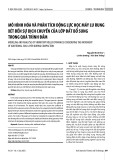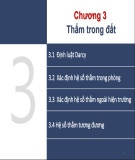
ISSN 1859-1531 - THE UNIVERSITY OF DANANG - JOURNAL OF SCIENCE AND TECHNOLOGY, VOL. 22, NO. 12, 2024 49
SAFETY FACTOR ANALYSIS OF NATURAL SLOPES USING RIGID PLASTIC
FINITE ELEMENT METHOD (RPFEM)
Pham Ngoc Quang*, Pham Ngoc Vinh
The University of Danang - University of Science and Technology, Vietnam
*Corresponding author: pnquang@dut.udn.vn
(Received: October 01, 2024; Revised: October 25, 2024; Accepted: November 14, 2024)
DOI: 10.31130/ud-jst.2024.428E
Abstract - In this study, a new method for analyzing safety factor
(Fs) of natural slopes was developed. Rigid-plastic constitutive
equation for soil materials and a slope stability analysis
framework were formulated to account for both soil properties
(cohesive strength c and friction angle ) and slope geometry
(slope angle β and slope height H). These models enable the
analysis of cohesive and frictional strengths within slopes while
avoiding the need for excessive element subdivision, thereby
allowing for high-precision analysis. To demonstrate the
effectiveness of the developed model, its validity was first
verified through numerical analysis of simple models with known
solutions. The results indicate that this method can reasonably
evaluate the stability of slopes across a wide range of soil
properties and geometric conditions.
Key words – Safety factor; Cohesive strength; Frictional
strength; Slope angle; Slope height; RPFEM.
1. Introduction
In natural slopes, the presence of weak soil layers,
particularly in relation to soil properties such as cohesion,
internal friction angle, and unit weight, often plays a
critical role in initiating slope failures. These weak layers
typically exhibit lower shear strength compared to the
surrounding soil, making them more susceptible to failure
under stress conditions. The failure mode of the slope is
predominantly governed by these localized weak layers, as
they act as planes of weakness where slip surfaces are
likely to form. Without taking these weak layers into
account during analysis, it is impossible to accurately
predict or represent the complex mechanisms involved in
slope failure.
In the case of landslides, once a slip surface is clearly
formed within the slope, it is often found that the weak
layer propagates along this surface, further reducing the
safety factor and exacerbating instability. The occurrence
of thin weak layers within slopes is not uncommon and can
significantly influence both the initiation and progression
of failure, directly impacting the overall safety factor [1 -
8]. These weak layers alter the stress distribution and
deformation behavior of the slope, leading to a failure
mechanism that is vastly different from what would occur
in homogeneous soil conditions. Consequently, the
evaluation of the safety factor, particularly with the
inclusion of weak layers, becomes a critical aspect of slope
stability analysis in geotechnical engineering. Accurately
modeling and understanding the behavior of these weak
layers under various loading conditions is crucial for
predicting potential failures and calculating reliable safety
factors. By incorporating these considerations, engineers
can develop more accurate models and design approaches
that ensure the long-term stability and safety of slopes in
natural environments.
This study focuses on slope stability analysis by
calculating the safety factor using the Rigid Plastic Finite
Element Method (RPFEM). The rigid plastic constitutive
model, developed from the upper bound theorem of limit
analysis, defines a relationship based on the governing
equations. In geotechnical engineering, Tamura et al. [9-11]
introduced the methodology for deriving this model.
Following Tamura's approach, the rigid plastic model in this
study incorporates shear strength reduction and penalty
methods, essential for evaluating the safety factor of slopes.
The accuracy of the method is validated through numerical
analysis of a simple model with a known solution. An in-
house RPFEM code developed by the author [12-25] is used
to compute the safety factor of the natural slope. The
RPFEM has proven effective in geotechnical engineering
applications, as demonstrated in previous works [26-34],
further supporting its reliability in calculating safety factors
and enhancing slope stability analysis.
The applicability of the developed constitutive model
will be assessed by evaluating the safety factor of natural
slopes, considering key factors like soil properties
(cohesion c and friction angle
) and slope geometry (slope
angle β and height H). It is anticipated that the safety factor
will exhibit significant variability depending on these
parameters, with the interaction between cohesion and
friction playing a crucial role that is influenced by both the
slope angle and the slope height. This study aims to
demonstrate the effectiveness of the proposed method in
accurately evaluating slope stability, thereby contributing
to improved engineering practices and more reliable safety
factor assessments for slopes in various geotechnical
contexts and applications.
2. Methodology for slope stability analysis
2.1. Rigid plastic constitutive equation for soil materials
Tamura et al. [9 - 11] derived a rigid-plastic constitutive
equation using a yield function of the type. The yield
function is expressed using the first invariant of the stress
tensor
( )
1
I tr=
and the second invariant of the deviatoric
stress tensor
2
1:
2
J=ss
as follows. Here,
2
tan
9 12tan
a
=+
and
2
3
9 12tan
c
b=+
are coefficients






























